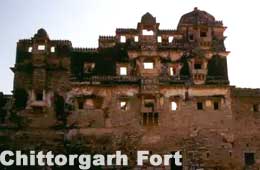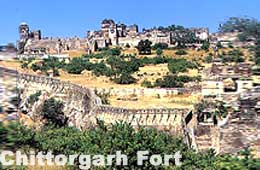| India Profile » Monuments and Temples in India » Chittorgarh Fort | |
Chittorgarh Fort | |
 | |
|
The Chittorgarh fort stands on a 180 m high hill that rises rapidly from the plains below. It is a massive structure with a 1 km zigzag accent to it. The road leads through seven gates namely Padan Pol, Bhairon Pol, Hanuman Pol, Ganesh Pol, Jorla Pol, Lakshman Pol, to the main gate Rampol. When you are between the second and third gate you will see two Chattris or cenotaphs built in honor of Jaimull and Kulla, who were the heroes of 1568 AD siege by Emperor Akbar. The main gate of the fort is called the Surajpol meaning the Gate of Sun. There are many palaces within the fort like the Rana Kumbha Palace, the Fateh Prakash Palace, the Tower of Victory and Rani Padmini's Palace, which are significant for their Rajput architectural features. The fortress of Chittorgarh epitomizes the romance and chivalry of the Rajput tradition. The main places of tourist interest around the fort are the two towers known as the 'Kirti Stambh' or Tower of Fame and the 'Vijay Stambh' or Tower of Victory. There are several temples, reservoirs and palaces constructed between the 9th and 17th centuries AD. There is a huge complex of Join temples within the fort. A big water reservoir is close to the opening where rani Padmini and other women are believed to have performed 'jauhar', an act of self-immolations by plunging in a large fire. Water flows out from a rock shaped in the form of cow's mouth and is called 'Gaumukh'. Other tourist spots worth visiting are the Bhimtal Tank, Neelkanth Mahadev Temple, Meera Temple, Kumbha Shyam Temple and Kalika Mata Temple dating back to the 8th century AD. The Kirti Stambh is a seven-storeyed tapering structure with a narrow stairway having 54 steps. It is 30 ft at the base and narrows down to 15 feet at the top and is decorated with Jain sculptures from outside. The date of its construction was around the 12th century AD. It is dedicated to the first Jain tirthankara, Adinath, and has an impressive 5 ft high statue of the saint.
Chittorgarh was sacked thrice by a stronger army. The first sack occurred in 1303 AD, when king Ala-ud-din Khilji besieged the fort in order to have possession of queen Padmini, wife of Rana Rattan Singh. In 1535 AD, Sultan Bahadur Shah of Gujarat besieged the fort and caused immense carnage. It is believed that 32,000 men donned the saffron robes of martyrdom and rode out to face a certain death. The women folks committed Jauhar led by Rani Karnawati. In 1568 AD, Mughal Emperor Akbar razed the fort to the rubble once again. In 1616 AD, the Mughal emperor Jehangir restored the fort to the Rajput but it was not resettled. |
|
 |
 Chittorgarh is the most sought after seat of power in India. It is situated 175 km to the east of Udaipur and is named after Chitrangad Maurya. Bappa Rawal, founder of the Sisodia dynasty, received Chittor as dowry from last the princess of the Solanki dynasty in mid-8th century AD. It covers an area seven mile covering 700 acres of land with its fortifications, palaces, temples and towers.
Chittorgarh is the most sought after seat of power in India. It is situated 175 km to the east of Udaipur and is named after Chitrangad Maurya. Bappa Rawal, founder of the Sisodia dynasty, received Chittor as dowry from last the princess of the Solanki dynasty in mid-8th century AD. It covers an area seven mile covering 700 acres of land with its fortifications, palaces, temples and towers. However, the most imposing structure within the Chittorgarh Fort is the Vijay Stambh. It was built by Maharana Kumbha in 1440 AD to celebrate his victory over Moh. Khilji. The tower stands on a pedestal of 47 square ft and 10 ft high, while the tower alone stands at a height of 122 ft and is 30 ft wide at the base. The tower is nine storeyed and is adorned with sculptures of Hindu deities and stories from the Ramayana and the Mahabharata with names given below each sculpture. A stairway with 157 circular steps leads to a terrace, which provides a breathtaking view of the city.
However, the most imposing structure within the Chittorgarh Fort is the Vijay Stambh. It was built by Maharana Kumbha in 1440 AD to celebrate his victory over Moh. Khilji. The tower stands on a pedestal of 47 square ft and 10 ft high, while the tower alone stands at a height of 122 ft and is 30 ft wide at the base. The tower is nine storeyed and is adorned with sculptures of Hindu deities and stories from the Ramayana and the Mahabharata with names given below each sculpture. A stairway with 157 circular steps leads to a terrace, which provides a breathtaking view of the city.